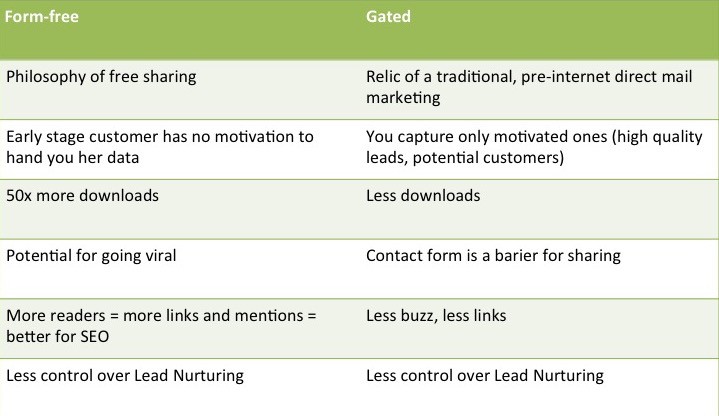To gate or not to gate: this is a question. Opinions are split. Some advocate for putting forms to capture leads before your valuable materials and others claim it’s better to let tour users read, distribute and share your pieces freely. We examine both approaches.
Lead Nurturing Bible. Download for free
1. Philosophy of relationship with customer
The difference between content gaters and non-gaters isn’t only a small technical argument or an issue of marketing mechanism. It’s about two philosophies of building relationships with the customers.
Non-gaters want to remove any obstacles that might stay between consumers and the brand. A form, which must be filled, which takes up users’ time, is a barrier, end of the story.
Such approach is focused on reciprocity: we share what we have, so we expect you (the customer) to share as well. It’s not exactly the internet thing. It happened before! Do you remember Grateful Dead, the famous band from the 70.? Back then, all other bands tried to stop fans from recording concerts and sharing videos. For musicians, it was like stealing their potential profits. But Grateful Dead were different. They encouraged fans to record, exchange, sell and do anything to the recordings. It made the group go viral: the news was spreading at the speed of light.
On the other hand, we have gaters, who want solid statistics and countable leads. For them content is not about emotional gratitude or lack of thereof; they want to monetize. So here they come, measuring and controlling the process.
Some say that gating the content is a relict from the old era where consumers had to give their home addresses to marketers so they can email them a paper catalogue. Is it so? Gated content has some pretty significant advantages.
2. Motivation
When someone just enters your website (during research or even by accident and has no idea who are you and what do you offer, but your ebook seems interesting), she has little motivation to give you her email address. Who are you? What will you do with the address, or, God forbid, a phone number? Will you trade it? Will you spam her inbox? Oh no, no downloading it, sorry, too much to risk.
It means that when someone downloads your gated content, she is pretty motivated to so. She isn’t just passing by; she either knows something about your company or would like to buy your products. In other words, such lead is of much higher quality than random downloaders who are just attracted by the topic.
3. A number of downloads
The numbers leave little room for doubt: form-free content is downloaded 50 times more often that gated one. But, again, quantity is not all. How many of such leads will become your customers in the log run? How many of them will share your content?
4. Going viral
There is one significant advantage of form-free content: it can go viral more easily. People don’t like to share websites that demand email address. If my friends will download that and will get spammed by the company, they will blame me, and I’ll feel stupid, so no, thanks, I don’t want the responsibility.”
So if you need a bit of social buzz, try to go for form-free materials.
5. Links, mentions, SEO
No surprises here: when your content is free to access, and people share it more willingly, the outcome is more links and better SEO. Regarding links, form-free materials perform better.
6. Lead Nurturing
When you ask for data when before download, what happens? The contact is added to an appropriate funnel, and you start nurturing her. You provide educational messages in the fashion you think is best. You decide what is more important, not the customer. You have more control, because with lead nurturing you shape user’s knowledge, so she doesn’t build it on her own. The lead is also approached by a salesperson at the best moment, basing on your experience.
On the other hand, when it comes to open content, you don’t nurture ad open up to nonlinear customer journey, which might lead to nowhere (you lose a lead after her chaotic research).
Tips
What it the result? We could call it even. Both methods have its pros and cons: either you want a buzz or qualified leads, but can you kill two birds with one stone? Try to combine these 2 methods.
Here is how.
1) Hybrid model
Use both types of content. Write an open blog and offer exclusive whitepapers in exchange for data. Also, you can give a form-free ebook as the first offer and present a free webinar that requires an email address in the free ebook. That way some people who read your material and find it interesting will register for the webinar.
2) Retargeting
The most painful thing about the form-free content is that you lose leads. They come, read, and go away. Will they ever come back?
To ensure they do, use retargeting. With Marketing Automation, you can address personalized ads in social media or RTB networks that will refer to the material given user downloaded, viewed or read.
So if someone downloaded a free ebook, you could show her a set of templates to download – but after giving you her email address.
3) Progressive profiling
It’s rarely used but excellent technique. How does it work? When new users visit your website, she has to give only one piece of data, like email address, so she isn’t discouraged with a long form. But when she comes next time and wants to download something more, you ask for additional information, such as phone number or name of the company. In such manner, your build user profiles gradually as your relationship develops. It can change the way people treat your contact forms.
4) Personalize all contact forms
Personalized contact forms perform best. Use information about customers’ interests to tailor the form to their needs.
To customize forms, use Marketing Automation platform.
And what are your tips? Do you gate your content or not? Why? Let us know in comments!



 Follow
Follow
















